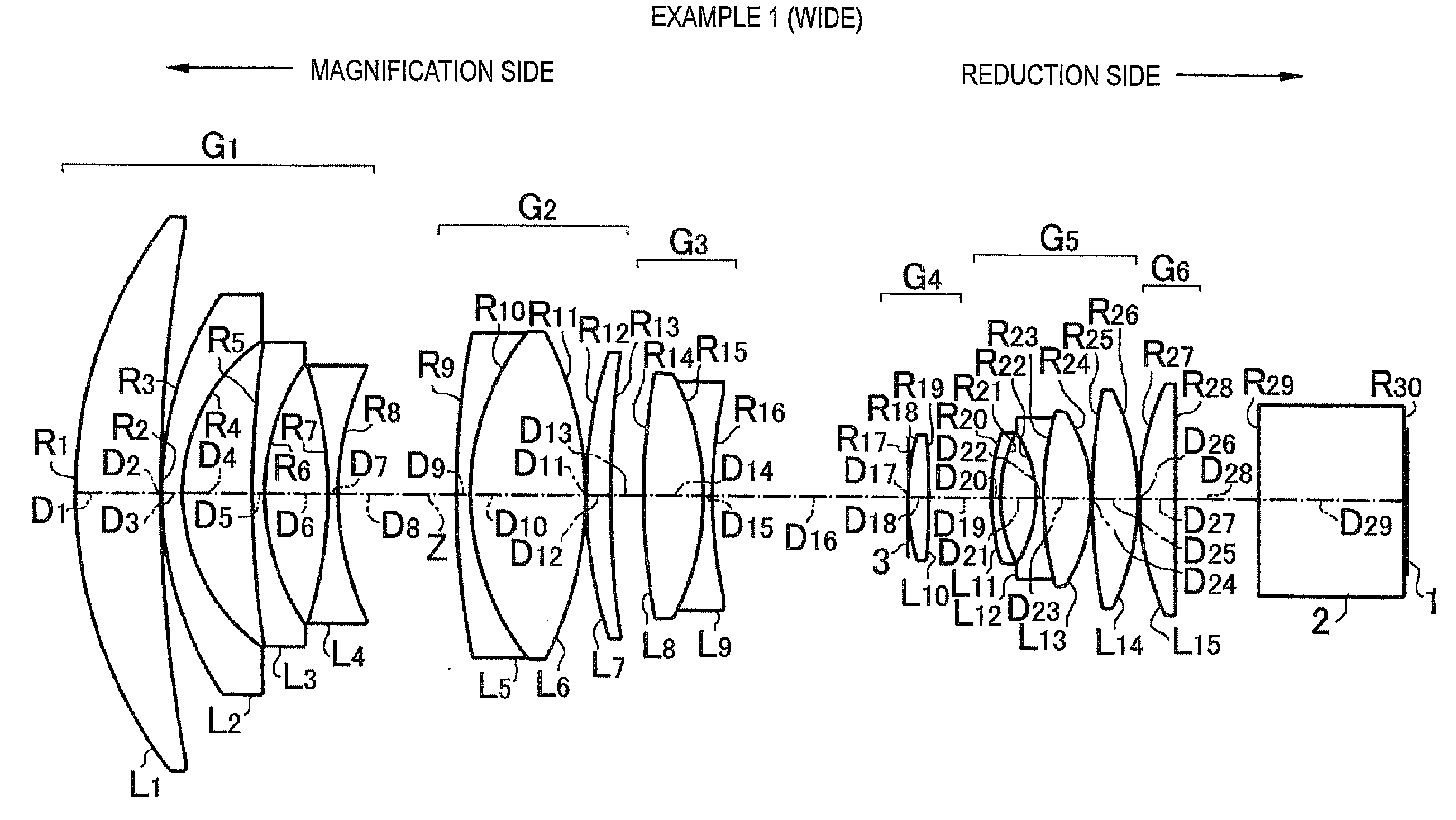Projecting zoom lens and projection type display apparatus
a projecting zoom and projection type technology, applied in the direction of printers, instruments, cameras focusing arrangements, etc., can solve the problems of increasing the fno of the lens, the effect of widening the field of zoom lens, reducing the amount of variations in various aberrations, and high resolution power
- Summary
- Abstract
- Description
- Claims
- Application Information
AI Technical Summary
Benefits of technology
Problems solved by technology
Method used
Image
Examples
example 1
[0087]A projecting zoom lens according to the present example 1, as described above, is structured as shown in FIG. 1. That is, the first lens group G1 includes, sequentially from the magnification side, a first lens L1 made of a positive meniscus lens having a convex surface facing the magnification side, a second lens L2 made of a negative meniscus lens having a convex surface facing the magnification side, a third lens L3 made of a negative meniscus lens having a convex surface facing the magnification side, and a fourth lens L4 made of a biconcave lens. And, the second lens group G2 includes, sequentially from the magnification side, a fifth lens L5 made of a negative meniscus lens having a convex surface facing the magnification side, a sixth lens L6 made of a biconvex lens, and a seventh lens L7 made of a positive meniscus lens having a convex surface facing the magnification side, while the fifth lens L5 and sixth lens L6 are connected to each other to from a cemented lens.
[0...
example 2
[0099]FIG. 3 shows a schematic structure of a projecting zoom lens according to an example 2. Basically, this projecting zoom lens, substantially similarly to the example 1, includes six lens groups. Specifically, the respective lens groups are structured in the following manner.
[0100]Firstly, the first lens group G1 includes, sequentially from the magnification side, a first lens L1 made of a positive meniscus lens having a convex surface facing the magnification side, a second lens L2 made of a negative meniscus lens having a convex surface facing the magnification side, a third lens L3 made of a negative meniscus lens having a convex surface facing the magnification side, and a fourth lens L4 made of a biconcave lens. And, the second lens group G2 is made of a cemented lens which includes, sequentially from the magnification side, a fifth lens L5 made of a biconcave lens and a sixth lens L6 made of a biconvex lens, while the fifth and sixth lens are connected together.
[0101]Also,...
example 3
[0111]FIG. 5 shows a schematic structure of a projecting zoom lens according to an example 3. Basically, this projecting zoom lens, substantially similarly to the example 1, includes six lens groups. Specifically, the respective lens groups are structured in the following manner.
[0112]Firstly, the first lens group G1 includes, sequentially from the magnification side, a first lens L1 made of a positive meniscus lens having a convex surface facing the magnification side, a second lens L2 made of a negative meniscus lens having a convex surface facing the magnification side, a third lens L3 made of a negative meniscus lens having a convex surface facing the magnification side, a fourth lens L4 made of a negative meniscus lens having a convex surface facing the magnification side, and a fifth lens L5 made of a biconcave lens. And, the second lens group G2 includes, sequentially from the magnification side, a sixth lens L6 made of a positive meniscus lens having a convex surface facing ...
PUM
 Login to View More
Login to View More Abstract
Description
Claims
Application Information
 Login to View More
Login to View More - R&D
- Intellectual Property
- Life Sciences
- Materials
- Tech Scout
- Unparalleled Data Quality
- Higher Quality Content
- 60% Fewer Hallucinations
Browse by: Latest US Patents, China's latest patents, Technical Efficacy Thesaurus, Application Domain, Technology Topic, Popular Technical Reports.
© 2025 PatSnap. All rights reserved.Legal|Privacy policy|Modern Slavery Act Transparency Statement|Sitemap|About US| Contact US: help@patsnap.com



